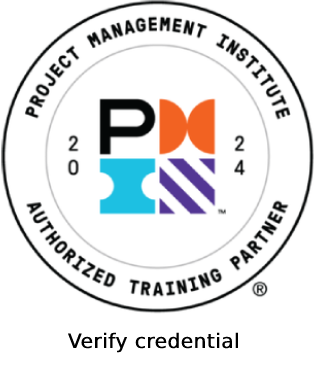Course Description
Get Started with Disciplined Agile
Begin your agile journey learning multiple agile approaches; understand how to use the Disciplined Agile tool kit and find your way of working (WoW). Comprehensive training introduces leading agile and lean approaches like Scrum, Kanban, SAFe® and more that frees you from any single agile framework and opens your options.

It is such a wonderful decision to take Project Victor’s PMP Exam Prep Course. All essential details from PMBOK Guide are covered and summarized within 5 days. The study guideline recommended by Dr. Petros help me a lot to get PMP certified in the first (…)
Key Features of Disciplined Agile Scrum Master (DASM) Certification
With DASM training and certification, you will:
- Understand the Disciplined Agile mindset and its underlying principles, such as pragmatism, the power of choice and adapting to context.
- Explore multiple leading agile and lean approaches like Scrum, Kanban, SAFe® and more.
- Learn about the fundamentals of agile and lean, and how to use both approaches effectively.
- Understand how to put these strategies into action on your agile team and ensure effective implementation.
- Learn how to apply the Disciplined Agile tool kit to discover the best way of working (WoW) for you and your agile team in your unique situation.
- Be prepared to take the Disciplined Agile Scrum Master (DASM) Certification exam. Your exam fee is included in tuition.
Requirements
- No agile experience is required – this is introductory training and certification built to educate you on agile and lean fundamentals and the Disciplined Agile tool kit with skills to immediately apply what you have learned.
- 2-day training
What is Disciplined Agile?
Disciplined Agile is not a framework, but rather a toolkit that focuses on the decisions you need to consider, the options available to you, and the trade-offs associated with these options. It shows you how to effectively combine strategies from Scrum, Agile Modeling, Extreme Programming, Kanban, Agile Data, SAFe, and many other approaches in a tailorable and scalable manner. Organisations that adopt Disciplined Agile go to market sooner, deliver value faster and make their customers happier.
- President of PMI Thailand Chapter (profile on PMI Thai website)

- He is a PMI licensed training instructor – profile on PMI global website.
- He is a Certified Program Management Professional (PgMP®) (Project Management Institute – www.pmi.org); Certificate # 2079271.
- He is a Certified Project Management Professional (PMP/CAPM®) (Project Management Institute – www.pmi.org); Certificate #1258917
- He is an Agile Certified Practitioner (PMI-ACP®) (Project Management Institute – www.pmi.org); Certificate #2600926
- He is a Certified Scrum Master (CSM®) (Scrum Alliance – www.scrumalliance.org); Certificant ID: 001062861
- He is a SAFe Program Consultant (SPC)® 5.0; Certificate ID: 50804412-3031
- He is a SAFe Agilist® 5.0 (www.scaledagile.com); Certificate ID: 23353981-8934
- He is Certified Risk Management Professional (RMP®) (Project Management Institute – www.pmi.org); Certificate #2033120
- He has experience managing and leading mega-projects (Information Technology, Airport-related, CCTV-related, Transport-related, and Power Infrastructure) in various industries.
- He is a commercial contract manager, reviewer, and advisor.
- He teaches part-time at King Mongkut University of Technology (Thonburi) – Graduate School of Management and Innovation (Master Degree in Project Management). He is an invited lecturer to Chulalongkorn University.
- He holds a Doctorate degree obtained from Assumption University of Thailand with an international record of publications in refereed journals with a special concentration on business management.
- He has trained more than 5000 program/project managers, project engineers, project coordinators, and project team members since 2010.
- He has helped certify more than 600 Project Management Professionals (PMP/CAPM/PMI-ACP) in Thailand.
- He is also a highly experienced speaker and trainer who is also passionate about Project Management.
- Passionate about the Agile methodologies and their applications in different business environments
Course Agenda
The primary focus of a DASM is their team. In this lesson, you’ll learn about Disciplined Agile teams, the characteristics of a leader, and how you can support your team so that they can be their best. This lesson will also introduce you to aspects of a team’s context that can impact how you form a team and evolve your way of working (WoW).
This lesson looks at business agility and how you, as a DASM, can guide your team through the agility journey. You’ll develop the skills to help your team choose a way of working (WoW) that aligns with their circumstances. Specifically, you’ll explore the different life cycles that DA supports and practice choosing the best-fit life cycle for a team.
The agile journey continues. As a DASM, you’ll coach your team to improve your way of working at a process level. This lesson introduces you to process goals associated with the Inception phase and shows where to look for alternatives to some of the agile practices covered previously. You’ll try working with the DA took kit to select new strategies based on a team’s context.
As a DASM, you’ll want to help your team tailor their way of working in every phase of your life cycle. This lesson covers the Construction phase, including lean concepts and tools that can help your team excel. You’ll use the DA tool kit to improve a team’s Construction phase processes.
This lesson takes you to a new level in preparing to be a DASM. You’ll apply what you have learned to your own team by selecting a Transition phase process you’d like to improve and determining an option to try as part of your continuous improvement efforts.
DASMs look beyond phases at ways their teams can improve overall. This lesson explores ongoing process goals. You’ll look at lean concepts and tools your team can implement across the phases and explore ways for your team to continue learning and improving.
Since Disciplined Agile is based on both agile and lean, a DASM should have a firm grasp of lean principles and how they function at a systems level. In this lesson, you’ll gain a deeper understanding of how lean principles and tools impact the organization, which will inform your work with your team.
We’ve Trained Professionals
across Global Companies













































Need more information on Trainings?
We’re a click away
Free Shipping
Free Shipping for orders over £130
Money Guarantee
Within 40 days for an exchange.
Flexible Payment
Pay with Multiple Credit Cards
Online Support
24 hours a day, 7 days a week
Don't compromise on quality!
Subscribe to the newsletter
- TEL : 0980 444 45 456
- MAIL : hello@demo.com
Don't compromise on quality!
- TEL : 0980 444 45 456
- MAIL : hello@demo.com
About Wooma
Help
Categories
Campaigns
Company
Resources
Contact Details
-
200/05, Narathiwat Ratchanakarin Road,
Chongnonsi Yannawa, Bangkok 10120 - info@projectvictor.com
- (66) 92 348 4772
- (66) 02 294 2492
Copyright © 2025. Project Victor Co., Ltd. All Rights Reserved.
- Call us on (66) 92 348 4772
“PMI,” “PMP,” “CAPM,” “PMI-ACP,” “PMBOK,” and the PMI Authorized Training Partner logo are registered marks of the Project Management Institute, Inc.
“ITIL®,” “PRINCE2®,” “MSP®,” and “P3O®” are registered trademarks of AXELOS Limited, used under permission of AXELOS Limited. View Disclaimer





